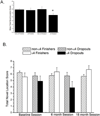Effects of epsilon4 on object recognition in the non-demented elderly
- PMID: 20044903
- PMCID: PMC4849126
- DOI: 10.2174/1874609811003020127
Effects of epsilon4 on object recognition in the non-demented elderly
Abstract
Previously we reported that apolipoprotein E (ApoE) epsilon4 negatively affects performance in the novel-image-novel-location (NINL) object recognition test in healthy non-demented elderly human study participants. In this study, the participants were invited to return for testing sessions 6 and 18 months after the baseline session. Using a longitudinal study design, effects of epsilon4 on NINL test performance were assessed in study "dropouts", participants that did not return for the second and/or third session(s), and "finishers", participants that returned for all sessions. There were effects of epsilon4 on dropout rates and NINL total scores as well as sub-scores in both dropouts and finishers. NINL total score was a predictor of epsilon4 participant dropout. Compared to non-epsilon4 dropouts, epsilon4 dropouts had lower NINL scores. In contrast, epsilon4 finishers had higher NINL scores than non-epsilon4 finishers. Thus, the NINL test could be a valuable tool in detecting pre-clinical signs of age-related cognitive impairments, particularly those associated with epsilon4 risk.
Figures






Similar articles
-
Novel image-novel location object recognition task sensitive to age-related cognitive decline in nondemented elderly.Age (Dordr). 2012 Feb;34(1):1-10. doi: 10.1007/s11357-010-9204-2. Epub 2011 Jan 14. Age (Dordr). 2012. PMID: 21234692 Free PMC article.
-
Effects of sex and APOE epsilon4 on object recognition and spatial navigation in the elderly.Neuroscience. 2007 Jun 15;147(1):6-17. doi: 10.1016/j.neuroscience.2007.03.005. Epub 2007 May 23. Neuroscience. 2007. PMID: 17509769
-
Lack of effect of the apolipoprotein E ε4 genotype on cognition during healthy aging.J Clin Exp Neuropsychol. 2014;36(7):742-50. doi: 10.1080/13803395.2014.935706. Epub 2014 Jul 15. J Clin Exp Neuropsychol. 2014. PMID: 25026037
-
Does apolipoprotein E genotype influence cognition in middle-aged individuals?Curr Opin Neurol. 2015 Dec;28(6):612-7. doi: 10.1097/WCO.0000000000000262. Curr Opin Neurol. 2015. PMID: 26402402 Review.
-
The Elusive Nature of APOE ε4 in Mid-adulthood: Understanding the Cognitive Profile.J Int Neuropsychol Soc. 2017 Mar;23(3):239-253. doi: 10.1017/S1355617716000990. Epub 2017 Jan 6. J Int Neuropsychol Soc. 2017. PMID: 28059047 Review.
Cited by
-
Dissociable effects of the apolipoprotein-E (APOE) gene on short- and long-term memories.Neurobiol Aging. 2019 Jan;73:115-122. doi: 10.1016/j.neurobiolaging.2018.09.017. Epub 2018 Sep 25. Neurobiol Aging. 2019. PMID: 30342272 Free PMC article.
-
Memory precision of object-location binding is unimpaired in APOE ε4-carriers with spatial navigation deficits.Brain Commun. 2021 Apr 23;3(2):fcab087. doi: 10.1093/braincomms/fcab087. eCollection 2021. Brain Commun. 2021. PMID: 33987536 Free PMC article.
-
Central and Peripheral Mechanisms in ApoE4-Driven Diabetic Pathology.Int J Mol Sci. 2020 Feb 14;21(4):1289. doi: 10.3390/ijms21041289. Int J Mol Sci. 2020. PMID: 32075060 Free PMC article.
-
Appraisal of cognition in preclinical Alzheimer's disease: a conceptual review.Neurodegener Dis Manag. 2012;2(2):183-195. doi: 10.2217/NMT.12.5. Neurodegener Dis Manag. 2012. PMID: 22798965 Free PMC article.
-
Novel image-novel location object recognition task sensitive to age-related cognitive decline in nondemented elderly.Age (Dordr). 2012 Feb;34(1):1-10. doi: 10.1007/s11357-010-9204-2. Epub 2011 Jan 14. Age (Dordr). 2012. PMID: 21234692 Free PMC article.
References
-
- Mahley RW. Apolipoprotein E: Cholesterol transport protein with expanding role in cell biology. Science. 1988;240:622–630. - PubMed
-
- De Blasi S, et al. APOE polymorphism affects episodic memory among non demented elderly subjects. Exp Gerontol. 2008 - PubMed
-
- Reynolds CA, et al. Longitudinal memory performance during normal aging: twin association models of APOE and other Alzheimer candidate genes. Behav Genet. 2006;36(2):185–194. - PubMed
-
- de Frias CM, et al. Cholesterol and triglycerides moderate the effect of apolipoprotein E on memory functioning in older adults. J Gerontol B Psychol Sci Soc Sci. 2007;62(2):P112–P118. - PubMed
Publication types
MeSH terms
Substances
Grants and funding
LinkOut - more resources
Full Text Sources
Medical
Miscellaneous
